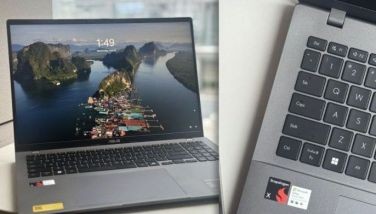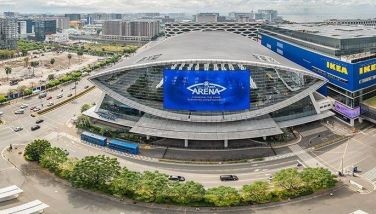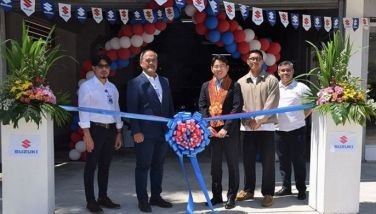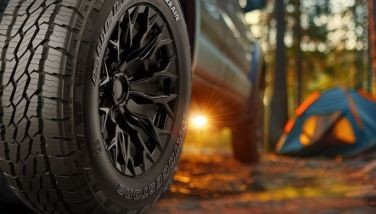Wheels Up at Mt. Pinatubo
MANILA, Philippines - “Is it possible to walk to Pinatubo from the Spa Town?” I asked our driver as our open air 4x4 Toyota jeep plowed through the gray wasteland. I couldn’t fully hear what he replied through the roar of the engine and the rush of wind blasting across our heads, but it sounded like, “Yes. But you’ll probably die.”
He was just half-joking, I gathered. Across the wide, dry riverbed farmers guided their carabaos along the sun-baked landscape. Sparse vegetation grew along the pale ash-covered terrain and, in the distance, walls of ash bordered the banks of the river where pyroclastic lahar once flowed – almost 20 years ago next month in a massive eruption that affected the entire world. Even with blue skies and a decent amount of clouds, anyone who planned a walk through the riverbed to the caldera of Mt. Pinatubo would be in for one serious trip. Extreme hikers are not unheard of, but more sensible travelers will opt for a quick jeep ride to the actual jump-off. Besides, there’s not much to see in the first 25 or so kilometers before the trail to the now-dormant volcano. The landscape is barren and scorching hot. A few streams trickle about at random intervals and you may get to chat with some of the farmers. That’s about it.
Our trek started at the Pinatubo Spa Town located in Sta. Juliana, Capas, Tarlac. It’s exactly what its name implies, offering spa services and facilities as well as transport to the volcano itself. This place is a preferred start point whenever tourists want to go to Pinatubo since it’s easily accessible via the national highway. Even better, the Subic-Clark-Tarlac Expressway (SCTEX) made it faster to get there. Each visitor has to register before leaving for the approximately 1½ to 2-hour trip to the hiking trail.
The default mode of transport here are the rugged 4x4 jeeps. Aside from a few hardy scooters from the locals, the 4x4s are your only shot at getting to Mt. Pinatubo. Able to run at high speed across the ash-covered fields, the 4x4s can carry up to six passengers, including the driver.
The ride was indeed fast, but far from smooth. This terrain was not meant for regular vehicles. An ordinary car would overheat and have its suspension buckling within half an hour, its radiator choking on the volcanic ash that flew up like storm clouds underneath our wheels. Somehow, every bump was tolerable; every tilt where we were left hanging on to the rollbars as the jeep went up a 45-degree angle was a joy. This was an adventure and the surroundings made you wonder if you were actually on another planet.
An hour in and we had to stop. Flanked by towering jagged peaks of ash, our drivers get the jeeps ready for the gradual ascent to the crater. Radiators are opened to steam and have their coolant replaced. The 4-wheel drives are prepped to take on the upcoming trails – a combination of long climbs and sudden steep descents. It only takes an hour and the landscape is breathtaking. At some high elevations we could see down into the provinces of Tarlac and Zambales. The lahar riverbed we just negotiated cuts a swath across the countryside and we could see the extent of damage it made back when the formerly dormant volcano erupted in June 1991.
 The trail leading to the crater lake looks almost like a parking spot – a plateau that leads into the “Skyway” trail. Our driver says the new trail is about half an hour shorter and was made after a landslide hit the old one. From here we leave the jeeps. Walking to the crater across the rocky terrain would only take an hour.
The trail leading to the crater lake looks almost like a parking spot – a plateau that leads into the “Skyway” trail. Our driver says the new trail is about half an hour shorter and was made after a landslide hit the old one. From here we leave the jeeps. Walking to the crater across the rocky terrain would only take an hour.
The hike isn’t as hard as you might believe, but I caution against underestimating it. People can still slip and fall on the rocks and the river current, no matter how seemingly small, can get powerful at certain points. The ascent is gradual and you’ll hardly feel it.
We were walking through what was basically the path that the lahar went as it flowed out of the Pinatubo crater. Against the rocks and boulders we traversed were steep walls on both sides, smooth from the passing of the pyroclastic flow. The gray surfaces looked unstable and the collection of rocks and debris at their base hinted that landslides still occurred here.
We couldn’t hear much wildlife as the rocks and walls gave way to greenery and surface foliage. Much of the small streams contained tadpoles. Lots of them. It’s a wonder that life can still grow out of the sulfuric waters that come from the crater. Some of the pools of water also hinted at iron deposits, what with rust-colored sediment resting at the bottom. About 20 minutes from the crater lake is a rest spot complete with restrooms. Before continuing, a sign taunts hikers about the time it takes to get to the crater relative to your age. A few more minutes walking through trees and we see a flight of stairs. It leads into our first glimpse of the Pinatubo crater lake.
An imposing sight, the turquoise water of the lake sparkles as it is surrounded by steep walls that make up the crater. The wall summits taper off to form sharp edges that continue to experience landslides through the years. The entrance has been made into a proper park with a small shed on top capable of housing a very small restaurant or souvenir store. There are a couple of view decks and at the bottom, another shed beside a few boats that can take you to the other side of the lake for a fee. The air was strong and chilly as the massive caldera generated its own weather system. The waters were sulfuric, deep and uncharted. Signs warned swimmers not to venture far from the shore or stay too long in the water. Despite the warnings, Pinatubo itself is a breathtaking beauty.
After an hour and a half of frolicking by the waters’ edge it was time to leave. The number of boats was limited so I wasn’t able to get to the other side as we were running out of time. It didn’t matter, staying by the shore was already very relaxing. Honestly, the hardest part of the trip was climbing the stairs from the lake shore back to the view deck. And once you knew the distance it became easier to walk back to our jeeps.
The driver glared at us because we still managed to take too long getting back. However, it was a minor hiccup in an otherwise worthwhile journey. I keep thinking about going back there, maybe spend more than just a few hours and possibly taking that boat ride to the other side. It’s something to look forward to.
For more info on getting a Mt. Pinatubo tour package, contact the PDC Pinatubo Spa Town at Sta. Juliana, Capas, Tarlac at tel. (045)493-0031, cel nos. 0909-951-3103, 0908-885-8479. Email at pdcspatown@yahoo.com. This trip was made possible by Lakbay Norte 2, a media familiarization trip by the Manila North Tollways Corporation (MNTC) and the North Philippines Visitors Bureau (NPVB). Lakbay Norte 2 was organized by the NPVB, a non-stock non-profit organization, in partnership with Victory Liner and Cebu Pacific, which provided the bus and plane transport to the various destinations. NPVB’s other partners include McDonalds, Smart, and Robinsons Land. This year’s participating brands were Flying V, Cebu Pacific, URC, DIZITAB, R.O.X., Sanuk, The North Face, COLUMBIA, ActivAsia, and Elite Ad.
- Latest






























